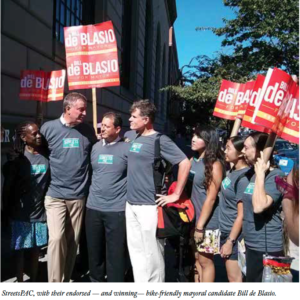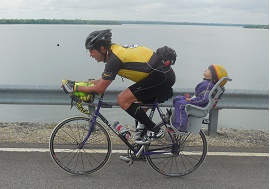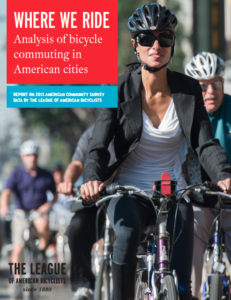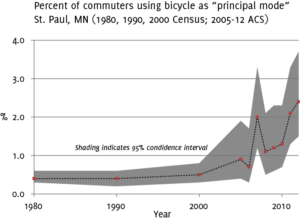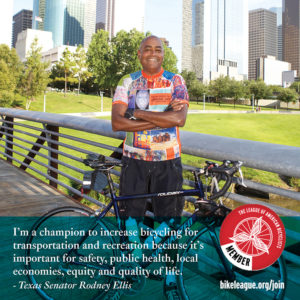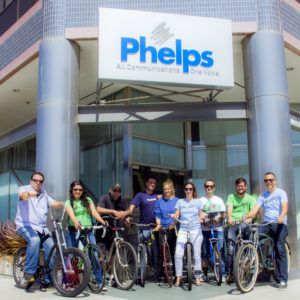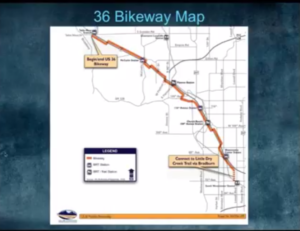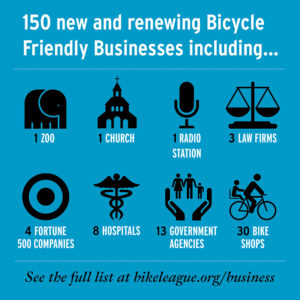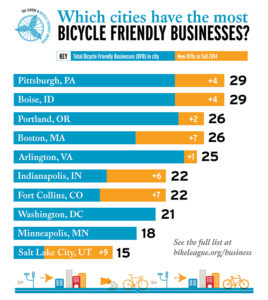Blog
Imagine you’re a safe-streets advocate living in a dreamscape of an expanding bike-lane network, widespread installation of public plazas and innovative government-sponsored programs aimed at improving street life, from summertime street closures to bike share to virtually on-demand public benches. Progress has been swift under the committed leadership of a mayor who understands the economic necessity of these programs and amenities to ensure that his city stays competitive — and his Commissioner of Transportation is unapologetically on the cutting edge of contemporary urban design.
Read More →The 2014 National Bike Challenge saw unprecedented participation from more than 47,000 riders across the country, pedaling more than 23 million miles.The National Bike Challenge, wrapping up its third year with a new award-winning website, saw 36% increase in riders and 25% more miles pedaled over last year. Challenge riders burned a collective 500,000 Ilbs. From May to September, riders logged miles, shared personal triumphs and united around bicycling, whether for fun, for work or for health.
Read More →UPDATE: We’ve released an extensive analysis of the new bike commuting data in a new report called “Where We Ride: An Analysis of Bicycle Commuting in American Cities.” Click here to download it (PDF), or scroll through the report below. This morning, the American Community Survey (ACS) released new data on bicycle commuting in the United States.
Read More →Perhaps the most widely used dataset related to bicycling in the United States is the annual American Community Survey (ACS), the successor to the decennial Census’ so-called “long form.” This survey asks a sub-sample of American households to provide information on a variety of topics such as income, health insurance, disability, housing, and—thankfully—transportation.
Read More →Senator Rodney Ellis may represent thousands of Houston residents when he takes his seat at the Texas capitol in Austin, but when he gets on his bike, he’s an advocate for safe and healthy communities on a much grander scale. A past speaker at the National Bike Summit and bicycle proponent at the annual gathering of the Congressional Black Caucus, Ellis is a leading cycling champion.
Read More →We released our latest round of Bicycle Friendly Business awardees — this biggest round ever for the program — this week. Over the next week, we’re highlighting some of the best stories we heard from the new and renewing honorees. For Phelps, a marketing and communications firm in Santa Monica, Calif., biking to work starts with biking to lunch. This post comes to us from Wesley High, an IT specialist with Phelps, which is a new Silver-level Bicycle Friendly Business.
Read More →This week Advocacy Advance released its latest resource, “Public-Private Partnerships for Transportation” (PDF). This concise primer answers basic questions about public-private partnerships (PPP, or P3) and how bicycling and walking can fit into these projects. Though P3s are becoming an attractive option, our resource goes over some potential benefits and problems with P3s, as well as additional considerations for bicycling and walking advocates.
Read More →A few years ago Advocacy Advance recognized the rise of local ballot initiatives to boost funding for transportation as a key opportunity to raise new funding for biking and walking projects. This summer we had the opportunity to partner with Americans for Transit to invest in new research to identify voters who support funding for transit and biking infrastructure.
Read More →Today, the League of American Bicyclists announced 150 new and renewing Bicycle Friendly Businesses (BFB) in 39 states and the District of Columbia. The largest group of awardees in the program’s history, this latest round grows the ranks of BFBs to more than 800 businesses, government agencies and Fortune 500 companies in 46 states and the District of Columbia.
Read More →Boise, Idaho, and Pittsburgh, Pa., had to laugh last spring: They were both tied for the most Bicycle Friendly Business awardees all-time in their cities. Both sides were then determined to reach the top spot come this Fall. Well, they both did a great job recruiting businesses to recognize the benefits of bicycling in the workplace, encouraging several businesses to apply. Boise and Pittsburgh, as of today’s Fall announcement, are tied again, with four new businesses each! Today, we hear from Boise’s Dave Fotsch, the director of Boise Bike Share, about this cities efforts this round. It’s going to be an exciting Spring for the Bicycle Friendly Business program…
Read More →